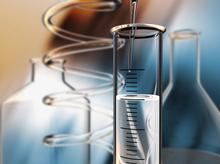The successful isolation of cells from equine umbilical cord blood for regenerative purposes has put the University of Guelph on the map as a leader in equine stem cell research.

Using equine umbilical cord blood for regenerative purposes
The complication is integrating cell-repaired cartilage with the underlying bone and adjacent normal healthy cartilage in horses.
In his latest research, Dr. Thomas Koch is able to isolate mesenchymal stromal cells (MSCs) for potential cartilage repair using a very simple, non-invasive procedure. Umbilical cord blood is obtained at the time of foaling by clamping the cord and collecting the blood into a transfusion bag.
“The long term goal is to find new treatment modalities for diseases and conditions where there currently are no good treatment modalities,” says Dr. Thomas Koch, who researches joint cartilage repair at Aarhus University, Denmark and the University of Guelph. Koch expands on one reason stem cell research is such a hot topic by explaining the concept of a reduced burden on the healthcare system, which could potentially result from curing incurable degenerative diseases.
Once at the lab, this blood is then put into a plastic container and then the cells that “love plastic” show their potential for regenerative research. Any unwanted floating cells are easily removed from the container because the desirable MSC cells actually adhere to the plastic and multiply! Koch can then create cartilage from these cells in the lab.
Studies for maintaining cells at the injury site are ongoing. The complication is integrating cell-repaired cartilage with the underlying bone and adjacent normal healthy cartilage. Koch is investigating sophisticated matrices and scaffolds as well as a technique known as mosaic arthroplasty.
In mosaic arthroplasty, a number of plugs consisting of both cartilage and bone are placed in the cartilage and bone defect in a cobblestone pattern, hence the name mosaic. Pioneered by Dr. Mark Hurtig from the University of Guelph, this option, although technically difficult, may allow a better integration between cartilage and bone.
Using umbilical cord blood cells to make bone cells and cartilage cells has earned Koch’s research international recognition. The application for bone healing in fracture and cartilage repair is promising. Now researchers are working on better ways of differentiating undifferentiated cells into cartilage cells so there will be enough cells for therapy.
Dr. Thomas Koch is employed by the Orthopedic Research Lab at Aarhus University in Denmark and funded by the Danish Research Agency for Technology, Production and Innovation. Additional operating funds are provided through: Grayson Research Foundation of Lexington, Kentucky; BioE Inc. of Minnesota, USA; SentrX Animal Care Inc. of Utah, USA; Morris Animal Foundation, USA and the Equine Guelph Research Fund.
Information for this new item is taken from a report written by Jackie Bellamy, Communications & Administration at Equine Guelph
